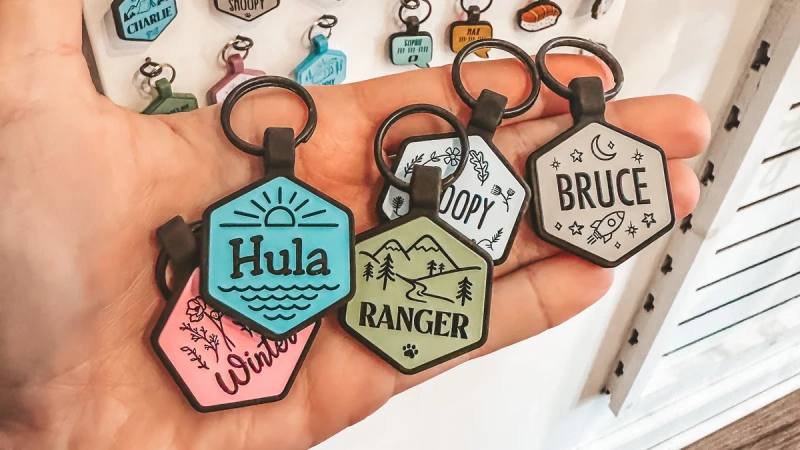
Does your dog tremble when seeing a harness? Many people share this experience.
Begin by building positive feelings about the harness for your dog. Slowly help them get used to it. Give tasty treats and keep sessions short and happy. This method builds their trust. Over time, wearing the harness should not feel stressful at all.
The first time I tried to put a harness on my dog, he looked at me like I was taking him to get shots at the vet. This made me feel really sad. Over time, I figured out how to make him feel good about the harness. I did not push it on him. Instead, I left the harness near his favorite places and gave him rewards when he sniffed or touched it. His favorite treats played a big role in these sessions. This method changed everything. The harness slowly turned into a normal part of our routine. Watching his body language was important, too. If he seemed stressed, we paused. Patience was needed. His happy tail wag on our walks made it all worth it.
Dogs can overcome harness fear with positive reinforcement.True
Positive reinforcement helps build a positive association with the harness.
Ignoring a dog's fear of harness will resolve the issue over time.False
Ignoring fear can worsen it; active desensitization is necessary.
Why do dogs fear harnesses?
Curious why your dog trembles at the sight of a harness? Many face this issue. You are not alone. Knowing the reason helps both enjoy walks more.
Fear in dogs often comes from bad experiences, physical pain or loud sounds. Knowing these triggers helps. Use good training to reduce your dog’s stress.

Negative Associations
I remember the first time I tried putting a harness on my rescue dog, Buddy. He backed away as if I held something scary! Over time, I realized his behavior came from past experiences, probably not happy ones. Dogs like Buddy often feel scared when they connect harnesses to bad memories. Maybe they were forced into one or felt trapped during a walk.
Example: A rescue dog might connect a harness with a past traumatic event. To help, owners can use positive reinforcement techniques1 like treats and playtime, gradually forming positive associations with the harness.
Physical Discomfort
Imagine wearing shoes that hurt or clothes that itch – it feels bad, right? That’s how dogs feel with tight harnesses. When Buddy acted unwilling, I checked the harness fit. A good fit should be snug but not tight, like comfy slippers. Soft materials really matter.
Tip: Ensure the harness is well-fitted and made from soft materials. Consider trying different designs, such as step-in harnesses, to see what suits your dog best. Here’s a guide to choosing the right harness2 that helped me a lot.
Sound Sensitivity
Buddy’s ears perked up at the smallest sound of the harness buckle, making him nervous. For dogs sensitive to sound, gentle exposure helps.
Solution: Desensitize your dog to these sounds by practicing with the harness clasp in a calm environment. Reward them for staying calm as you mimic the sounds during training sessions3. These sessions became bonding moments where he learned the sounds weren’t so scary.
Harness Features and Comfort Table
| Feature | Comfort Level | Description |
|---|---|---|
| Padding | High | Cushions prevent chafing, ideal for long walks |
| Adjustability | Medium | Allows for better fit but might need fine-tuning |
| Material Softness | High | Soft materials increase comfort, reducing stress |
Every dog is unique, just like we have different likes and dislikes. Understanding what makes your dog special is important. With some patience and a well-planned training journey4, making walks enjoyable is definitely possible.
Dogs fear harnesses due to past negative experiences.True
Negative associations with harnesses can cause fear in dogs.
All dogs are comfortable with any type of harness.False
Harness fit and material can affect a dog's comfort.
How Can Positive Reinforcement Help?
Have you ever thought about how saying ‘good job’ might change the way someone acts? Let’s explore the concept of positive reinforcement. It is a powerful tool for motivation. It’s true.
Rewards increase good behaviors by giving treats or praise. People enjoy positive feedback and feel encouraged. They probably repeat the actions when they see benefits. Constant rewards build a lively atmosphere. Happy environments inspire more good actions.

Understanding Positive Reinforcement
Belief in praise holds great power. Cheering my dog for a new trick or thanking team members for effort shows that rewarding good behavior leads to more of it. When my dog sits, a treat brings joy, teaching her that sitting brings rewards. Simple connections are very strong.
In educational settings5, teachers perform wonders with kind words. Praise for raising hands or joining in can really inspire students who might be shy otherwise.
Applications in Animal Training
Animal training requires patience and positive reinforcement together. Teaching a dog to sit might seem tough at first. Each successful sit gets a treat or a gentle pat, signaling they’re doing well. Over time, my dog understood that commands lead to rewards. Obedience then becomes natural.
| Behavior | Reinforcement Type | Example Reward |
|---|---|---|
| Sitting | Positive | Treat or praise |
| Fetching | Positive | Playtime or affection |
Giving rewards consistently is crucial, something I learned firsthand. It keeps training effective and builds trust with my pets.
Impact in Workplace Management
At work, positive reinforcement goes beyond boosting productivity. It helps morale and community grow. I recall when my boss recognized my efforts with a "thank you" during a meeting—amazing feeling! Public recognition can inspire others and create a space where everyone feels valued.
Imagine a workplace scenario6 where meeting goals gains attention. Such recognition lifts individuals and sets standards for colleagues, creating a positive chain reaction.
Psychological Benefits
Focusing on rewards instead of punishment transforms places into supportive environments. I noticed how anxiety decreases and confidence rises, whether in therapy or personal growth. Celebrating small successes matters.
Balancing rewards and helpful feedback encourages growth while keeping the mood positive. It’s important to balance reinforcement with constructive feedback7, ensuring that growth areas are addressed while maintaining a positive outlook.
Using positive reinforcement wisely changes behavior in many areas, making every interaction more fulfilling.
Positive reinforcement increases desired behavior likelihood.True
Rewards after desired actions make behaviors more frequent.
Negative reinforcement is the same as positive reinforcement.False
Positive adds rewards; negative removes unpleasant stimuli.
What Are Effective Desensitization Techniques?
Do you sometimes think your anxiety stops you from enjoying life? Desensitization could really help.
Effective ways to become less afraid include slowly facing scary things, practicing calmness and changing negative thoughts. These methods slowly reduce worry. They help grow confidence bit by bit.

Understanding Desensitization
Desensitization involves confronting things that cause discomfort, step by step. Think of it as gently dipping toes into chilly water rather than plunging in. This slow approach transforms experiences, especially in behavioral therapy8, to address phobias and anxiety. I once feared public speaking. Taking small steps with a helpful therapist allowed me to control my reactions and gradually feel more confident.
Types of Desensitization Techniques
-
Systematic Desensitization
Imagine relaxing on a beach, hearing waves, while calmly considering a scary thought. This method combines calmness and small exposure. List fears from least to most scary.
Step Description 1 Relaxation Training 2 Constructing Anxiety Hierarchy 3 Gradual Exposure Deep breathing before each fear level helps maintain calmness.
-
Flooding
Not for the timid! Picture diving into deep water immediately. Flooding means facing the largest fear directly without any gradual steps. It is intense but very effective for some, like my friend who found success when done carefully.
-
Cognitive Restructuring
This method focuses on thought changes. I once wrote negative thoughts and challenged them until they lost power. Writing and stopping thoughts helped change mental patterns.
Practical Applications
-
For Pets:
Dogs may fear a harness, but slow desensitization helps greatly, similar to harness conditioning methods9. It makes pets less scared of new gear. -
For Phobias:
Systematic desensitization also helps with fears like flying or high places. Step by step, it trains the mind to view these situations as less frightening.
Incorporating Technology
Technology elevates desensitization through virtual reality (VR). It offers a safe setting to face fears like speaking in public before real-life experiences.
Using these techniques daily demands patience and commitment. Guidance from a therapist or coach improves effectiveness and reduces fear. In the end, the path to overcoming fears becomes supportive instead of overwhelming.
Systematic desensitization uses relaxation techniques.True
Systematic desensitization involves relaxation exercises to manage anxiety.
Flooding involves gradual exposure to feared stimuli.False
Flooding requires immediate, intense exposure, not gradual steps.
When Should You Seek Professional Help?
Do you sometimes feel overwhelmed by your thoughts, unsure if you need to seek help? You are not alone. Many people experience this.
Seek a professional’s help when constant emotional pain or changes in behavior disturb your everyday life. A mental health specialist provides clarity and support. They give personalized ways to handle your feelings.

Recognizing the Signs
There was a time I always felt as if a big weight was on my shoulders. It wasn’t just a bad day here and there. It was a nonstop fight with sadness and worry. These feelings affected my friendships and job. That was when I knew help was needed. Maybe similar feelings mean it’s time to consider professional help10.
The Benefits of Professional Guidance
A mental health expert felt like a safe place in a storm for me. They gave me a space without judgment where I could finally sort out my feelings. With their help, I learned ways to handle my emotions that suited me, promoting long-term mental wellness11. It really helped me feel more in control and probably helped me find lasting peace.
| Sign | Why It’s Important |
|---|---|
| Persistent Sadness | Indicates potential depression |
| Sudden Mood Changes | Could signal mood disorders |
| Social Withdrawal | Often linked to anxiety or depression |
| Difficulty Concentrating | May point to stress or burnout |
The Role of Support Networks
Supportive friends and family became very important to me, even though I needed more help too. They comforted me when life was hard, offering perspective that made it easier to navigate difficult times12. However, professional intervention becomes critical when support networks can’t alleviate underlying issues.
Misconceptions About Seeking Help
Long ago, I believed asking for help showed weakness. But reaching out is actually one of the bravest actions. Understanding that seeking help is strength, not weakness, is vital. Experts know how to maintain privacy and make their space feel personal and secure, ensuring your journey remains personal and confidential13. Learning this helped beat the stigma.
Persistent sadness always indicates depression.False
Persistent sadness can indicate depression, but not always. Other factors may contribute.
Social withdrawal is linked to anxiety or depression.True
Social withdrawal is a common symptom associated with anxiety and depression.
Conclusion
Help your dog overcome harness fear through positive reinforcement, gradual exposure, and patience. Understand triggers like negative associations and discomfort to create a stress-free experience for walks.
-
Discover how positive reinforcement can change your dog’s perception of a harness, turning it into a source of happiness. ↩
-
Learn how to choose a comfortable, well-fitted harness that suits your dog’s needs. ↩
-
Find methods to help your dog become accustomed to the sounds of harness clasps. ↩
-
Get insights on building an effective training routine for introducing your dog to a harness. ↩
-
Learn how teachers use positive reinforcement to improve student engagement and motivation. ↩
-
Explore how businesses use positive reinforcement to enhance employee performance. ↩
-
Discover how to balance positive reinforcement with constructive feedback for better outcomes. ↩
-
Explore this link to learn how desensitization is applied within behavioral therapy to help manage fears. ↩
-
Discover effective training techniques to help your pet overcome harness fear through desensitization methods. ↩
-
Discover common symptoms indicating it’s time for professional mental health support. ↩
-
Learn how therapy can enhance mental wellness and provide personalized coping strategies. ↩
-
Understand the importance of support networks alongside professional help. ↩
-
Find out how therapists ensure confidentiality and respect client privacy. ↩



